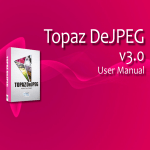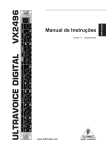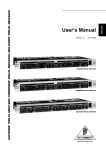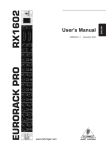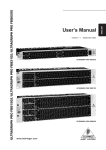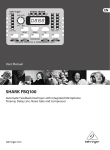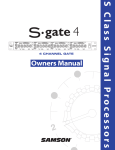Download Behringer Ultravoice Digital VX2496 User`s manual
Transcript
Version1.2 1.1 VERSION September 2003 ENGLISH ULTRAVOICE DIGITAL VX2496 Users Manual ULTRAVOICE DIGITAL VX2496 SAFETY INSTRUCTIONS DETAILED SAFETY INSTRUCTIONS: 1) Read these instructions. 2) Keep these instructions. 3) Adhere to all warnings. 4) Follow all instructions. CAUTION: To reduce the risk of electric shock, do not remove the cover (or back). No user serviceable parts inside; refer servicing to qualified personnel. 5) Do not use this device near water. 6) Clean only with a dry cloth. 7) Do not block any ventilation openings. Install in accordance with the manufacturers instructions. WARNING: To reduce the risk of fire or electric shock, do not expose this device to rain and moisture. This symbol, wherever it appears, alerts you to the presence of uninsulated dangerous voltage inside the enclosurevoltage that may be sufficient to constitute a risk of shock. This symbol, wherever it appears, alerts you to important operating and maintenance instructions in the accompanying literature. Please read the manual. 8) Do not install near any heat sources such as radiators, heat registers, stoves, or other apparatus (including amplifiers) that produce heat. 9) Do not defeat the safety purpose of the polarized or grounding-type plug. A polarized plug has two blades with one wider than the other. A grounding type plug has two blades and a third grounding prong. The wide blade or the third prong are provided for your safety. If the provided plug does not fit into your outlet, consult an electrician for replacement of the obsolete outlet. 10) Protect the power cord from being walked on or pinched particularly at plugs, extension cords, and the point at which they exit the equipment. 11) Only use attachments/accessories specified by the manufacturer. 12) Use only with the cart, stand, tripod, bracket, or table specified by the manufacturer, or sold with the device. When a cart is used, use caution when moving the cart/ device combination to avoid injury from stumbling over it. 13) Unplug this piece of equipment during lightning storms or when not used for long periods of time. 14) Refer all servicing to qualified service personnel. Servicing may be required when this piece of equipment has been damaged in any way, such as when power supply cord or plug is damaged, liquid has been spilled or objects have fallen inside, it has been exposed to rain or moisture, it does not operate normally, or has been dropped. 2 ULTRAVOICE DIGITAL VX2496 ULTRAVOICE DIGITAL PROFESSIONAL HIGH-PERFORMANCE MIC PREAMPLIFIER/VOICE PROCESSOR WITH AES/EBU OUTPUT VX2496 = Ultra low-noise discrete vintage-design Mic/Line input stage = 24-bit AES/EBU output with selectable 44.1, 48, 88.2 and 96 kHz sampling rates or external clocking = Universal sample rate synchronization via Wordclock or Digital input = Authentic Tube emulation circuitry for typical tube and tape saturation sounds = True RMS expander for extremely smooth noise reduction = Opto compressor for inaudible level control and creative sound processing = Integrated dynamic Enhancer replaces high-frequencies lost through compression = Voice-optimized Equalizer specially designed for voice enhancement = Opto de-esser for quick removal of excessive sibilance from your vocal track = High-performance VCA for extremely natural sound processing = Accurate LED metering for crystal-clear level and processor indication = Servo-balanced gold-plated XLR connectors for all main inputs and outputs = Illuminated switches ensure perfect operation in dark stage environments = Shielded toroidal power transformer for lowest noise interference = High-quality components and exceptionally rugged construction ensure long life = Conceived and designed by BEHRINGER Germany 3 ULTRAVOICE DIGITAL VX2496 FOREWORD TABLE OF CONTENTS Dear Customer, welcome to the team of BEHRINGER users and thank you very much for expressing your confidence in us by purchasing the VX2496. rental market. Writing this foreword for you gives me great pleasure, because it represents the culmination of many months of hard work delivered by our engineering team to achieve a very ambitious goal: to offer you a high-quality device whose flexibility makes it suitable for use both in studios and in the P.A. The task of designing our new ULTRAVOICE DIGITAL VX2496 certainly meant a great deal of responsibility which we assumed by focusing on you, the discerning user and musician. Meeting your expectations also meant a lot of work and night shifts. But it was fun, too. Developing a product usually brings a lot of people together, and what a great feeling it is when all who participated in such a project can be proud of what theyve achieved. It is our philosophy to share our enjoyment with you, because you are the most important member of the BEHRINGER team. With your highly competent suggestions for new products youve made a significant contribution to shaping our company and making it successful. In return, we guarantee you uncompromising quality as well as excellent technical and audio properties at an extremely reasonable price. All of this will enable you to give free rein to your creativity without being hampered by budget constraints. We are often asked how we manage to produce such high-quality devices at such unbelievably low prices. The answer is quite simple: its you, our customers! Many satisfied customers mean large sales volumes enabling us to get better purchasing terms for components, etc. Isnt it only fair to pass this benefit on to you? Because we know that your success is our success too! I would like to thank all of you who have made the ULTRAVOICE DIGITAL possible. You have all made your own personal contributions, from the developers to the many other employees at this company, and to you, the BEHRINGER user. My friends, its been worth the effort! Thank you very much, Uli Behringer 4 1. INTRODUCTION ......................................................... 4 1.1 Before you get started ................................................... 5 2. CONTROL ELEMENTS ............................................... 5 2.1 2.2 2.3 2.4 2.5 2.6 2.7 Discrete vintage input stage .......................................... 5 Expander and tube emulation ......................................... 5 Opto compressor ........................................................... 6 Voice-optimized EQ ........................................................ 6 Opto de-esser and master section ................................ 6 Rear panel connectors ................................................... 7 Digital AES/EBU output and wordclock option ............... 7 3. RECORDING WITH THE ULTRAVOICE DIGITAL .......... 7 4. MIXING WITH THE ULTRAVOICE DIGITAL .................. 8 4.1 Hints about analog output level setting .......................... 8 4.2 Hints about digital output level setting ............................ 8 5. LIVE APPLICATIONS WITH THE ULTRAVOICE DIGITAL ...................................................................... 8 6. INTEGRATION INTO A RECORDING SYSTEM ............ 9 7. AUDIO CONNECTIONS ............................................... 9 7.1 Advice about using an adapter for converting from the AES/EBU to the S/PDIF format ......................... 9 8. SPECIFICATIONS ..................................................... 10 9. WARRANTY .............................................................. 11 1. INTRODUCTION Thank you for the confidence you have placed in us by purchasing the ULTRAVOICE DIGITAL VX2496. With the ULTRAVOICE DIGITAL you have acquired an extremely powerful device for creatively processing your music. Its professional design means the VX2496 can produce excellent results, both in the studio and live. Numerous features, such as the opto compressor or the voice-optimized EQ mean you can even process signals with a very wide dynamic range and tailor them to the overall sound of your music. In addition, the VX2496 has a digital AES/EBU output with a high-resolution 24-bit/96 kHz A/D converter and a wordclock input enabling synchronization to external devices. The BEHRINGER ULTRAVOICE DIGITAL combines a microphone preamp, control amplifier and equalizer and is ideally suited for connection to a hard disk recording system where you could, for example, record vocals directly onto the hard drive. The highest quality is maintained, as any potential deterioration caused by inserting into a mixing console is eliminated. In addition, the integrated A/D converter ensures optimum conversion of the analog signal with no degradation of sound quality. And, due to its professional signal-processing features, the ULTRAVOICE DIGITAL is also the ideal tool for optimizing live vocals. To familiarize yourself with the functions of the VX2496, simply connect any audio signal and try out each individual control. Use a relatively uncompressed signal (for example, one of your own recordings) in order to judge the effect of the opto-compressor. CDs are usually pre-compressed, which makes it difficult to hear how the compressor changes the sound. 1. INTRODUCTION ULTRAVOICE DIGITAL VX2496 Once you have developed a feel for the individual components, you can unleash your creativity by combining individual functions. The SIG LED above the gain control illuminates when an input signal is present. This manual first describes the terminology used, so that you fully understand the VX2496 and its functions. Please read the manual carefully and keep it for future reference. Ensure that the CLIP LED lights up only with peak signals. If it is constantly lit or if distortion can be heard, reduce the input level using the GAIN control. + 1.1 Before you get started Your ULTRAVOICE DIGITAL was carefully packed in the factory, and the packaging is designed to protect the unit from rough handling. Nevertheless, we recommend that you carefully examine the packaging and its contents for any signs of physical damage, which may have occurred during transit. + If the unit is damaged, please do NOT return it to BEHRINGER, but notify your dealer and the shipping company immediately. Otherwise, claims for damage or replacement may not be granted. The ULTRAVOICE DIGITAL has a low-cut filter which can be used to remove low-frequency interference from the microphone signal. This function is activated with the LO CUT button. This filter has a slope of 12 dB/oct. With the FREQUENCY control, you can select the cutoff frequency below which the low-frequency component will be removed (range 15 - 360 Hz). The Ø INV shifts the input signal phase by 180°. Use this function if the use of multiple microphones results in cancellations of specific frequency ranges. 2.2 Expander and tube emulation Be sure that there is enough space around the unit for cooling and, to avoid overheating, please do not place your ULTRAVOICE DIGITAL on power amplifiers, etc. The mains connection is via the enclosed power cord and a standard IEC receptacle. It meets all international safety certification requirements. + Please make sure that all units have a proper ground connection. For your own safety, never remove or disable the ground conductor from the unit or the AC power cord. Before you connect your ULTRAVOICE DIGITAL to the mains, please make sure that the voltage setting on your unit matches the local voltage! The fuse holder above the AC power connector has 3 triangular markings. Two of these three triangles are aligned with one another. The VX2496 is set to the voltage shown next to these markings and can be switched over by turning the fuse holder by 180°. IMPORTANT: This does not apply to export models designed exclusively for 120 V operation! Fig. 2.2: Expander and tube emulation An expander reduces the volume of a signal in lowlevel passages. This way, interference such as tape noise and spill can be removed. The IN/OUT button switches the expander in or out of the signal path. 2. CONTROL ELEMENTS The THRESHOLD control determines the level at which the expander cuts in. 2.1 Discrete vintage input stage The amount of gain reduction is determined using the DEPTH control. The higher the value, the more the gain is reduced. When the GATE button is pressed, the expander functions as a noise gate. This has a more radical effect on the sound, as it not only attenuates but also completely eliminates low-level passages. For this reason the gate function should primarily be used with individual signals, thus not risking any unwanted effect on the existing recording. The four GAIN REDUCTION LEDs display the amount of gain reduction from -5 to -30 dB. Fig. 2.1: Discrete Vintage input stage This section of the ULTRAVOICE DIGITAL is a preamp where you regulate the input level of the microphone or line level signal. Use the LINE button to select the type of input signal (pressed = LINE, not pressed = MIC). Press the +48 V button to power a condenser microphone. Dynamic microphones do not require this phantom power supply. The GAIN control sets the input level. The scale -12 to +12 dB relates to the LINE input whereas the scale +10 to +60 dB relates to the MIC input. The tube emulation function allows you to enhance vocals with subtle distortion and tape saturation effects, replicating analog tapes and tube amps. In this mode, the VX2496 adds upper harmonics to the signal, thus enhancing its sound in the high-frequency range. The IN/OUT button activates or deactivates tube emulation. The DRIVE control determines the intensity of the saturation effect. The further it is turned to the right (HOT), the greater the effect. The amount of upper harmonics generated is also dependent on the level set at the discrete vintage input stage. The SIG LED lights up when tube emulation is active. To avoid internal overloading, the CLIP LED should only light up during peak level passages. It should not be constantly illuminated. 2. CONTROL ELEMENTS 5 ULTRAVOICE DIGITAL VX2496 The TUNING control lets you determine the frequency range to be saturated. All other ranges remain unaffected, allowing the effect to be finely tailored. 2.4 Voice-optimized EQ To process the whole frequency spectrum, use the FULL BW button. This makes the TUNING control inoperative. 2.3 Opto compressor Fig. 2.4: Voice-optimized EQ The voice-optimized EQ is a 3-band equalizer used for sound shaping. You can boost or cut frequency ranges in order to equalize weaknesses in the input signal. Activate the voice-optimized EQ with the IN/OUT button. Fig. 2.3: Opto compressor The opto compressor reduces the dynamic range of the input signal, i.e. the level difference between soft and loud passages. Peaks above a certain value are reduced, smoothing out the sound. The IN/OUT button activates the compressor. Use this to directly compare compressed and uncompressed signals. The THRESHOLD control determines the level at which the opto compressor starts to compress the signal. Only if this value is exceeded will the signal be processed. The dynamics of passages whose levels lie below the threshold are not affected. The lower the threshold value, the greater the compression. The HARD RATIO button sets the amount of signal gain reduction to its maximum. This produces a highlycompressed, flat sound. Do not use this function if you wish to retain the natural dynamics of the sound. If the FAST button is pressed, the opto compressor starts compressing very quickly after the threshold is exceeded. The overall sound appears significantly more compressed and the result is a very powerful sound. Use the TUNING control to select a frequency range (130 Hz to 720 Hz). The selected frequency range can be boosted or cut using the WARMTH control. Cut employs a narrower bandwidth than that used for boost, enabling you to tailor the filter to your specific needs. Use the PRESENCE control to add high and upper-mid frequencies to the signal (around 1.7 kHz). This helps to push vocals to the forefront with more presence in the overall sonic image. Use the BREATH control to boost or cut typical noises associated with the voice (e.g. breathing) at around 8 kHz. The ABSENCE button cuts the level of those frequencies that cause an unappealing, harsh sound. These lie around the area of 4 kHz. 2.5 Opto de-esser and master section The RELEASE control determines how quickly the compression stops after the signal falls back below the threshold. The longer the release time, the more compressed the sound will appear to be, but also the more smoother. The OUTPUT control regulates the output volume of the compressed signal. The compression process reduces the level of signal and this control is used to raise its level again (known as make-up gain). Certain frequency ranges may be lost during compression. These can be regained by using the integrated enhancer. The sound is subjectively rounded off and acquires a new brilliance. The six GAIN REDUCTION LEDs display the amount of compression. The level reduction displayed ranges from -3 to -24 dB. Fig. 2.5: Opto de-esser and master section Sibilance is an unwanted effect that can occur with some voices, whereby hissing sounds like that of s or sh are produced. With the opto de-esser, sibilance can easily be removed from the signal. Depress the IN/OUT button to activate the opto de-esser. The THRESHOLD control determines the amount by which sibilance should be suppressed. The lower the value, the more comprehensively sibilance is removed. Use the CUT FREQ control to select the frequency range to be reduced. The ACTIVE LED lights when the opto de-esser is functioning. The intensity of the LED reflects how hard the opto de-esser is working. 6 2. CONTROL ELEMENTS + + ULTRAVOICE DIGITAL VX2496 To avoid coloring the character of the sound, do not set the threshold too low when using the opto de-esser. When the threshold is set at its optimal value, the effect should only be recognizable by direct comparison to the unprocessed signal using the IN/OUT button. The LINE input is on a balanced 1/4" TRS jack. + Use the MASTER FADER to match the output signal level to the input sensitivity of the following device (e.g. your DAT or hard disk recorder). Start by tuning the master fader right down and increase it slowly to the desired level. If you start with too high a level, you risk overloading the inputs of the devices that follow! The six OUTPUT LEVEL LEDs show the level of the output over a -10 to +15 dB range. Ensure that the output level does not go into overload otherwise the signal at the DIG OUT output will be too high and cause distortion. Use the POWER button to turn on the ULTRAVOICE DIGITAL. + This is the balanced XLR connector for a microphone (MIC) or line source. When the Line key is pressed, XLR and the jack connector are connected in parallel. If one line signal is fed into both inputs at the same time, the overall level of the output signal becomes lower, and both signals are mixed with one another in the same ratio. Please avoid connecting a mic and a line-level signal (CD player, sound card) to the input of your VX2496 at the same time. The low impedance of the microphone would make the line signal barely audible. Additionally, this could also damage the mic. 2.7 Digital AES/EBU output and wordclock option 2.6 Rear panel connectors Fig. 2.8: The ULTRAVOICE DIGITAL digital interface The digitally converted audio signal of the ULTRAVOICE DIGITAL appears at the DIG OUT (AES/EBU) output. Fig. 2.6: Mains connector and fuse holder + FUSE HOLDER/VOLTAGE SETTING. Before connecting the unit to the mains, ensure that the voltage setting matches your local voltage. A blown fuse should only be replaced by a fuse of the same type and rating. On some units, the fuse holder can be switched to one of two positions, i.e. 230 V and 120 V. Should you desire to operate the unit outside Europe at 120 V, a higher fuse rating is required (see chapter 1.1). The mains connection is on an IEC receptacle. An appropriate power cord is included. SERIAL NUMBER. Please take the time to complete and return the warranty card within 14 days after the date of purchase to benefit from our extended warranty. Or simply register online at www.behringer.com. The serial number needed for the registration is located at the top of the unit. Use the SAMPLING RATE switch to select the sampling rate at which the VX2496 analog signal is converted. You can choose a sample rate frequency of 44.1, 48, 88.2 or 96 kHz. If you want to lock to an external wordclock, the SAMPLING RATE switch should be set to EXT. Wordclock for synchronization of the VX2496 can be fed from an external device into the WC IN input. This connector is a BNC coaxial jack and is only active when the SAMPLING RATE switch is set to EXT. The ULTRAVOICE DIGITAL VX2496 features a 24-bit/96 kHz A/D converter with digital AES/EBU output. This allows you to record the digital output direct onto a digital medium without the need of an external A/D converter. Thus the ULTRAVOICE DIGITAL can be seamlessly integrated into a hard disk recording system. When several digital devices are integrated into a digital recording system with, for instance, a digital mixing console, all the digital devices must be synchronized to a common wordclock signal. For this reason the VX2496 has a wordclock input which enables it to be locked to an external device. It supports all sampling rates from 32 to 96 kHz. 3. RECORDING WITH THE ULTRAVOICE DIGITAL Fig. 2.7: ULTRAVOICE DIGITAL connections These are the MAIN outputs of the ULTRAVOICE DIGITAL on balanced XLR and 1/4" TRS jacks. The XLR RECORDING output is for connection to a DAT recorder, hard disk recorder or similar device and is sourced pre de-esser. This is the INSERT section with two 1/4" mono jacks as SEND and RETURN for connecting an additional effects device. The signal is sourced post low-cut filter of the input stage. When recording with the ULTRAVOICE DIGITAL, you should strive to achieve as natural a sound as possible at the best possible quality. During the mix the signal can then be given any required special treatment, with the original recorded signal always remaining pure. 1) Set an appropriate input level using the discrete vintage input stages GAIN control. 2) Be sure to do everything possible to achieve the best sound before it reaches the ULTRAVOICE DIGITAL. This includes being especially careful to find the optimal position for the microphone and ensuring that the surrounding acoustics enhance the sound in the desired fashion. Then, turn all the ULTRAVOICE DIGITAL controls off to initialize the dry signal. 3. RECORDING WITH THE ULTRAVOICE DIGITAL 7 ULTRAVOICE DIGITAL VX2496 3) + If necessary you can then smooth out the dynamics of the vocal slightly with the opto compressor. Be sure not to compress the signal too much; the compressor can always be used again after the recording. Also, do not use the hard ratio function at this stage as it makes a very audible difference in the signal. If the vocalist constantly changes his distance from the microphone during recording, extreme dynamic fluctuations may result. In this case, a higher level of compression should be used. Keep the threshold relatively low on the opto compressor to obtain a normal volume level. To avoid having to compress the signal too much, try to maintain a constant distance between the vocalist and the microphone while recording. Backing vocals should be highly compressed so they can be present throughout the recording without volume fluctuations. 4) The voice-optimized EQ allows you to equalize deficiencies in the sound image that could not be corrected in advance. However, do not use extreme settings here either, as you can add more EQ when mixing. The voice-optimized EQ can be used to deal with the following problems: s If the vocals sound muddy in the bass range, you can cut the low-frequency area of the signal by using the WARMTH control. Set the control to full cut and locate the intrusive frequency range with the TUNING control so that the voice sounds more balanced. You should try this in solo mode first. Then, listen to the voice with the rest of the mix and adjust the WARMTH control until the overall sound is right. s If the voice sounds too edgy, use the ABSENCE button on the voice-optimized EQ. This will attenuate these harsh frequencies without compromising the natural quality of the overall sound. In addition, you can boost the low frequencies with the WARMTH control or, if necessary, improve the peaky characteristic of the signal by lowering the BREATH or PRESENCE control. s If the voice is getting lost in the mix, increase the PRESENCE control. Boosting this range will help the voice to cut through more. s If the vocal sound is not brilliant enough, you can add peaks using either the PRESENCE or the BREATH control. Additionally, you can use the opto-compressor enhancer to add upper harmonics artificially. 5) If the signal contains unwanted frequency areas, use the expander and the opto de-esser to remove them. Sibilance can be removed with the opto de-esser, but first you must isolate the intrusive frequency range: s Activate the voice-optimized EQ and turn the BREATH control up to exaggerate sibilant frequencies. If you have already used the EQ, first make a note of the original settings so they can be subsequently reset. s Activate the opto de-esser and, using a low threshold, turn the CUT FREQ control until the sibilance is reduced. s Now turn the voice-optimized EQ off again and reset the BREATH control to its original position. s Now set the threshold so the ACTIVE LED only lights up when sibilance is present. The expander enables you to remove intrusive noise from quiet passages. To do this, turn the THRESHOLD control to the far left and turn it up slowly with DEPTH set at medium. Find the value at which you notice an audible suppression of the quiet spots without impairing the vocal sound. Only use the gate in exceptional casesif, for instance, you want to achieve a specific effect. It radically affects the sound and could thus ruin your recording. 6) Use the tube emulation for a classic analog tape recording sound. 7) Finally, use the MASTER FADER to regulate the ULTRAVOICE DIGITALs output. 8 4. MIXING WITH THE ULTRAVOICE DIGITAL Go ahead and experiment with the mixing possibilities of the ULTRAVOICE DIGITAL and push it to its limits. It is often the case that extreme effect and filter settings are needed to optimally integrate a signal into the mix. If a voice ultimately appears as very full and present in the mix, it usually means the signal has been thoroughly and truly tweaked. Vocals usually have reverb added during the mix. If you notice intrusive noise (e.g. sibilance) in the reverb, use the opto de-esser to remove it as follows: s Remove the sibilance from the vocal as previously described in chapter 3.5 and drive the reverb unit via one of the main outputs (not via the INSERT path as it is sourced before the de-esser). Make sure the reverb unit is set to 100% wet, i.e. there is no dry direct signal present. s The reverb signal can now be mixed at the console with the signal from the VX2496s RECORDING output. This is sourced before the de-esser, and in this way sibilance is removed only from the reverb signal, not the main voice itself. The expander can be used to remove spill from other instruments which, for example, may have been picked up by the microphone from the vocalists headphones. Remember that compression would have the opposite effect, as the signal is limited at the loudest spots. Any spill would then become effectively louder. Although the ULTRAVOICE DIGITAL was principally designed to record vocals, you can of course also use it to record and mix other signals. 4.1 Hints about analog output level setting The output level meter has been calibrated to +4 dBu. For Main Out, this means the following: if OUTPUT LEVEL METER shows 0 dB, +4 dBu is connected to Main Out. This way, you have positioned the optimal level of the output signal in order to create maximum rejection with sufficient headroom. Hint: Some equipment requires a lower input signal level (-10 dBV; in home recording domain). Use the input signal level displays of such equipment as well as the output level control of the VX2496 to create optimal adjustments. 4.2 Hints about digital output level setting The maximum level for digital signals is 0 dBFS. If the OUTPUT LEVEL-LEDs indicate +15 dB, this signal level is located at the digital output of the VX2496. Always keep in mind that a signal level higher than 0 dBFS/+15 dB will immediately lead to harsh distortion. Therefore, we suggest that you always stay well below this value in order to avoid distortion and increase headroom for signal peaks. Please always make sure that the clip LED at the input is seldom or never lit. + 5. LIVE APPLICATIONS WITH THE ULTRAVOICE DIGITAL The ULTRAVOICE DIGITAL is a versatile problem-solver and sound-shaper both in live and studio environments. On a small stage, short distances between the microphone and the monitor speaker can lead to unpleasant feedback. In this case the VX2496 opto de-esser could be used to suppress feedback: s Set the THRESHOLD control relatively low. s Use the CUT FREQ control to find the frequency causing the feedback. s Now turn the threshold up far enough to eliminate the feedback while maintaining an unaffected vocal signal as much as possible. 5. LIVE APPLICATIONS WITH THE ULTRAVOICE DIGITAL ULTRAVOICE DIGITAL VX2496 Loud volume can lead to large amounts of spill on stage, i.e. the microphones do not just pick up one signal (e.g. vocal), but many other signals from the stage. This can be a major problem, as the individual signals cannot be easily controlled independently. Use the expander to isolate individual signals and to lessen of spill. The level of the spill is lowered while the louder wanted signal is unaffected. The gate function also lends itself well to this application as unwanted signals can be completely eliminated in this way. You must be careful, however, to ensure that the main signal is not clipped as the gate cuts off when it falls below the threshold. This could even cause quiet passages to disappear even though they are meant to be heard. The gate is also ideally suited to processing impulse sounds (e.g. snare, bass drum, toms etc.) as these are relatively short signals that neither swell nor ring out. Fig. 7.2: 1/4" TS connector 6. INTEGRATION INTO A RECORDING SYSTEM As mentioned at the beginning of this manual, the ULTRAVOICE DIGITAL is ideally suited to direct connection to a recording medium, such as a DAT recorder, analog tape machine, or even a hard disk recording system without the use of a mixing console. Furthermore, an extremely clean signal is produced as the potential noise produced by looping through a mixing console is eliminated from the outset. You can integrate the VX2496 into a hard disk recording system without having to use an additional A/D converter. For such cases, the ULTRAVOICE DIGITAL has a 24-bit/96 kHz A/D converter with digital AES/EBU output. The wordclock input allows the VX2496 to be locked to external devices. Of course, you can also successfully integrate the ULTRAVOICE DIGITAL into your studio conventionally with a mixing console. 7. AUDIO CONNECTIONS The BEHRINGER ULTRAVOICE DIGITAL VX2496 hasexcept for the insert connectorsstandard electronically servobalanced inputs and outputs. The circuit design has automatic hum suppression with balanced signals and operates problem free even at high levels. Externally-induced mains hum is thus efficiently suppressed. The servo-function automatically detects when connector pins are unbalanced and changes the nominal level internally by 6 dB so that there is no difference in level between input and output signals. + Please ensure that only qualified persons install and operate the device. During installation and operation the user must have sufficient electrical contact to earth. Electrostatic discharges might affect the operation of the unit. Fig. 7.3: 1/4" TRS connector 7.1 Advice about using an adapter for converting from the AES/EBU to the S/PDIF format The VX2496 makes the digital signal available in the AES/EBU format. If you want to connect equipment that receives a digital signal in the S/PDIF format, you will need an adapter. Please note that different standardization of both formats may lead to problematic adapter performance. Normally, this is how the polarity of the AES/EBU connector is laid out: 1=GND, 2=HOT, 3=COLD. Figure 7.4 clarifies the design of the adapter. Keep in mind that the connection between different pieces of equipment should be as short as possible. Fig. 7.4: Adapter for a connection between AES/EBU and S/PDIF formats Fig. 7.1: XLR connections 7. AUDIO CONNECTIONS 9 ULTRAVOICE DIGITAL VX2496 8. SPECIFICATIONS AUDIO INPUTS MIC Line Insert Return Impedance MIC Line Insert Return Max. Input Level MIC Line CMRR Insert Return AUDIO OUTPUTS Recording Out XLR Main Out XLR Main Out Jack Impedance Rec. Out XLR connector, HF shielded, balanced XLR connector and 1/4" jack HF shielded, balanced 1/4" jack unbalanced 1.3 kΩ unbalanced, 2.6 kΩ balanced XLR connector and 1/4" jack 10 kΩ unbalanced, 20 kΩ balanced 10 kΩ unbalanced +11 dBu unbalanced and balanced XLR and jack +21 dBu balanced and unbalanced +21 dBu typical 40 dB, >60 dB @ 1 kHz (except Insert Return) Electronically controlled servo-balanced output stages Electronically controlled servo-balanced output stages 1/4" jack unbalanced 120 Ω balanced, 60 Ω unbalanced @ 1 kHz Main Out XLR 120 Ω balanced, 60 Ω unbalanced @ 1 kHz Main Out Jack 100 Ω unbalanced @ 1 kHz Insert Send 100 Ω unbalanced @ 1 kHz Output Level Rec. Out max. +21 dBu balanced and unbalanced Main Out XLR max. +21 dBu balanced and unbalanced Main Out Jack max. +21 dBu unbalanced Insert Send max. +21 dBu unbalanced SYSTEM DATA Bandwidth 20 Hz to 20 kHz, +0/-0.6 dB Frequency Response Line: <10 Hz to >200 kHz, +0/-1.7 dB -> Main Out MIC: <10 Hz to >200 kHz, +0/-2.5 dB -> Main Out S/N Ratio 123.6 dB dynamics -> Insert Send 118.5 dB dynamics -> Main Out 122 dB dynamics -> Recording Out 130 dB E.I.N, Mic In -> Insert Send 105 dB Line -> Insert Send @ +4 dBu/1 kHz THD 0.006% typ. @ -30 dBu, 1 kHz, Gain 30 dB, Mic In -> Insert Send 0.01% typ. @ -30 dBu, 1 kHz, Gain 30 dB, Mic In -> Main Out 0.001% typ. @ +4 dBu, 1 kHz, Unity Gain, Line In -> Insert Send 0.004% typ. @ +4 dBu, 1 kHz, Unity Gain, Line In -> Main Out DIGITAL OUTPUT Type Standard Output Impedance Nom. Output Level High-resolution 24-bit AKM A/D converter AES/EBU / XLR transformer-balanced 110 Ω balanced 5 V peak-to-peak INTERNAL SAMPLING FREQUENCY 44.1 / 48 / 88.2 / 96 kHz (switchable) WORDCLOCK INPUT Type Frequency Range Input Impedance Nom. Input Level EXPANDER/GATE SECTION Type Threshold Ratio Attack Release COMPRESSOR SECTION Type Threshold Ratio Manual Release Time RMS Expander variable (OFF to +10 dB) Expander: variable (1:1 to 3:1) Gate: 1:oo <1 msec / 20 dB, fixed 100 msec / 20 dB, fixed Output Opto Compressor variable (-25 to +10 dB) switchable (3:1 / 9:1) variable (10 dB / 10 msec to 10 dB / 1.5 sec) 10 dB / 10 msec Fast: 20 dB / 10 msec variable (0 bis +20 dB) DE-ESSER SECTION Type Filter Frequency Filter Quality Attenuation VAD (Voice-Adaptive)-De-Esser 2.7 to 12 kHz program-dependent, max. Q = 4 max. 18 dB Manual Attack Time TUBE EMULATION SECTION Filter Frequency variable, 800 Hz to 12kHz Peak Frequency Full Bandwidth, lower Cut-off Frequency = 200 Hz Characteristic Band Pass, 1st Order (6 dB/Oct.) Full Bandwidth: High Pass, 1st Order (6 dB/Oct.) Boost variable, max. 20 dB VOICE OPTIMIZED EQ SECTION Bands 3 Filter Quality Boost: 0.4 / Cut: 3 Filter Frequencies Breath: Type shelving, lower Cut-off Frequency 10 kHz Presence: Type peak, Peak Frequency 1.5 kHz Warmth: Type peak, semiparametric Peak Frequency variable from 130 to 720 Hz POWER SUPPLY Mains voltage USA/Canada 120 V~, 60 Hz Europe/U.K./Australia 230 V~, 50 Hz Japan 100 V~, 50 - 60 Hz General export model 120/230 V~, 50 - 60 Hz Power Consumption max. 25 W Fuse 100 - 120 V~: T 630 mA H 200 - 240 V~: T 315 mA H Mains Connection Standard IEC Receptacle DIMENSIONS (H x W x D) approx. 1 ¾" (44.5 mm) x 19" (482.6 mm) x 8 ½" (217 mm) WEIGHT approx. 2.2 kg SHIPPING WEIGHT approx. 3.4 kg BNC 31 to 100 kHz 100 kΩ 2 to 5 V peak-to-peak BEHRINGER makes every effort to ensure the highest standard of quality. Necessary modifications are carried out without notice. Thus, the specifications and design of the device may differ from the information given in this manual. 10 8. SPECIFICATIONS ULTRAVOICE DIGITAL VX2496 9. WARRANTY § 1 WARRANTY CARD/ONLINE REGISTRATION To be protected by the extended warranty, the buyer must complete and return the enclosed warranty card within 14 days of the date of purchase to BEHRINGER Spezielle Studiotechnik GmbH, in accordance with the conditions stipulated in § 3. Failure to return the card in due time (date as per postmark) will void any extended warranty claims. Based on the conditions herein, the buyer may also choose to use the online registration option via the Internet (www.behringer.com or www.behringer.de). § 2 WARRANTY 1. BEHRINGER (BEHRINGER Spezielle Studiotechnik GmbH including all BEHRINGER subsidiaries listed on the enclosed page, except BEHRINGER Japan) warrants the mechanical and electronic components of this product to be free of defects in material and workmanship for a period of one (1) year* from the original date of purchase, in accordance with the warranty regulations described below. If the product shows any defects within the specified warranty period that are not excluded from this warranty as described under § 4, BEHRINGER shall, at its discretion, either replace or repair the product using suitable new or reconditioned parts. In the case that other parts are used which constitute an improvement, BEHRINGER may, at its discretion, charge the customer for the additional cost of these parts. 2. If the warranty claim proves to be justified, the product will be returned to the user freight prepaid. 3. Warranty claims other than those indicated above are expressly excluded. § 3 RETURN AUTHORIZATION NUMBER 1. To obtain warranty service, the buyer (or his authorized dealer) must call BEHRINGER (see enclosed list) during normal business hours BEFORE returning the product. All inquiries must be accompanied by a description of the problem. BEHRINGER will then issue a return authorization number. 2. Subsequently, the product must be returned in its original shipping carton, together with the return authorization number to the address indicated by BEHRINGER. 3. Shipments without freight prepaid will not be accepted. § 4 WARRANTY REGULATIONS 1. Warranty services will be furnished only if the product is accompanied by a copy of the original retail dealer’s invoice. Any product deemed eligible for repair or replacement by BEHRINGER under the terms of this warranty will be repaired or replaced within 30 days of receipt of the product at BEHRINGER. 2. If the product needs to be modified or adapted in order to comply with applicable technical or safety standards on a national or local level, in any country which is not the country for which the product was originally developed and manufactured, this modification/adaptation shall not be considered a defect in materials or workmanship. The warranty does not cover any such modification/adaptation, irrespective of whether it was carried out properly or not. Under the terms of this warranty, BEHRINGER shall not be held responsible for any cost resulting from such a modification/adaptation. handling of the product by the user. This also applies to defects caused by normal wear and tear, in particular, of faders, crossfaders, potentiometers, keys/buttons, tubes and similar parts. 4. Damages/defects caused by the following conditions are not covered by this warranty: V improper handling, neglect or failure to operate the unit in compliance with the instructions given in BEHRINGER user or service manuals. V connection or operation of the unit in any way that does not comply with the technical or safety regulations applicable in the country where the product is used. V damages/defects caused by force majeure or any other condition that is beyond the control of BEHRINGER. 5. Any repair or opening of the unit carried out by unauthorized personnel (user included) will void the warranty. 6. If an inspection of the product by BEHRINGER shows that the defect in question is not covered by the warranty, the inspection costs are payable by the customer. 7. Products which do not meet the terms of this warranty will be repaired exclusively at the buyer’s expense. BEHRINGER will inform the buyer of any such circumstance. If the buyer fails to submit a written repair order within 6 weeks after notification, BEHRINGER will return the unit C.O.D. with a separate invoice for freight and packing. Such costs will also be invoiced separately when the buyer has sent in a written repair order. § 5 WARRANTY TRANSFERABILITY This warranty is extended exclusively to the original buyer (customer of retail dealer) and is not transferable to anyone who may subsequently purchase this product. No other person (retail dealer, etc.) shall be entitled to give any warranty promise on behalf of BEHRINGER. § 6 CLAIM FOR DAMAGES Failure of BEHRINGER to provide proper warranty service shall not entitle the buyer to claim (consequential) damages. In no event shall the liability of BEHRINGER exceed the invoiced value of the product. § 7 OTHER WARRANTY RIGHTS AND NATIONAL LAW 1. This warranty does not exclude or limit the buyer’s statutory rights provided by national law, in particular, any such rights against the seller that arise from a legally effective purchase contract. 2. The warranty regulations mentioned herein are applicable unless they constitute an infringement of national warranty law. * Customers in the European Union please contact BEHRINGER Germany Support for further details. 3. Free inspections and maintenance/repair work are expressly excluded from this warranty, in particular, if caused by improper The information contained in this manual is subject to change without notice. No part of this manual may be reproduced or transmitted in any form or by any means, electronic or mechanical, including photocopying and recording of any kind, for any purpose, without the express written permission of BEHRINGER Spezielle Studiotechnik GmbH. BEHRINGER is a registered trademark. ALL RIGHTS RESERVED. © 2003 BEHRINGER Spezielle Studiotechnik GmbH. BEHRINGER Spezielle Studiotechnik GmbH, Hanns-Martin-Schleyer-Str. 36-38, 47877 Willich-Münchheide II, Germany Tel. +49 2154 9206 0, Fax +49 2154 9206 4903 9. WARRANTY 11











